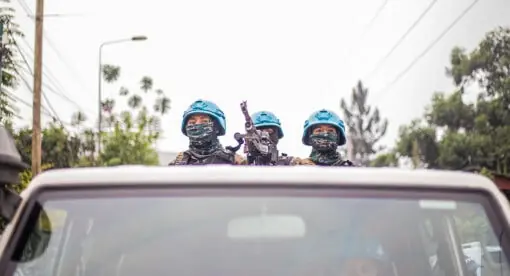On July 6, 2020, Dr. Husham al-Hashimi was killed by gunmen outside his home in the Iraqi capital Baghdad. He had submitted a series of articles to the Newlines Institute before his death, and we will publish those articles throughout the summer.
Editor’s Note: This Terrain Analysis is part 17 of “ISIS 2020” – a series of briefings about the current status of the Islamic State by authors from different parts of the region. It is published by the Newlines Institute’s Nonstate Actors program. Parts one, two, three, four, five, six, seven, eight, nine, ten, eleven, twelve, thirteen, fourteen, fifteen, and sixteen have been released weekly since April 28.
The Islamic State’s new leaders are emerging from defeat with an adaptable mindset and ideological flexibility that will allow them to remain ensconced within the core ISIS territories of Iraq and Syria, especially by focusing on local alliances and outreach to other jihadist groups. The new leaders have realized that indefinite attacks on security forces and collaborators are insufficient without local partnerships. ISIS demonstrated this new approach after a consecutive assassination campaign targeting village mukhtars, forging alliances built on convenience and shared sectarian grievances. It now seeks to reinforce these alliances, as revealed in intelligence reports and multiple interactions with its new members and leaders.
Key Aspects of ISIS’s New Strategy
ISIS’s new leaders served as some of the most important middle and field commanders during the organization’s emergence and ideological evolution between 2010 and 2014. Their roles and efficacy were clearly demonstrated in the conflict zones in Iraq and Syria. That the men who spent several years operationalizing the strategic guidance from up above now constitute the apex leadership underscores a significant level of institutionalization of the transnational jihadist movement.
Although the ideology of ISIS’s new leaders can be traced to other Salafist-jihadist groups from the 1990s, their recorded history goes back only to when they pledged allegiance to ISIS founder Abu Musab al-Zarqawi in 2003. At that time, many factors helped shape their ideology in the Iraq context:
- Sunnis in Iraq felt defeated and marginalized, believing that the U.S. invasion was responsible for empowering anti-Sunni forces — particularly the country’s Shiite majority, which was led by Iran to cultivate Shiite Islamism.
- The first generation of takfiri (those who declare other Muslims to be apostates) leaders from 2003 onwards was deeply opposed to the nascent Iraqi democracy and the drafting of the post-Saddam constitution. Al-Zarqawi and Abu Omar al-Baghdadi became increasingly vicious in dealing with other religious and sectarian groups, with special ire directed toward Shiites, who were dominating the emerging post-Baathist republic.
- The 2007-08 defeat of al Qaeda’s Iraqi branch by the U.S. military and Sunni Arab tribes led to the emergence of a new generation of local enemies to takfiri groups and organizations, such as tribal factions led by prominent Sunni chieftains Sheikh Abdul Sattar Abu Risha, Sheikh Jabbar al-Fahdawi, Sheikh Subah al-Mahalawi, and Sheikh Faisal al-Issawi.
- The new ISIS leaders acquired experience in financial management and intelligence operations, and those skills allowed them to access and set up in abandoned villages and cities where residents were prevented from returning due to sectarian, ethnic, security, and economic reasons. The new leaders changed ISIS’s mode of operation by focusing even more overwhelmingly on the Sunni-Shiite conflict and by offering economic incentives for recruitment.
Articles published in ISIS’s weekly Al Naba newspaper in October 2019 and voice messages from new ISIS spokesperson Abu Hamza al-Qurashi al-Muhajir announced the start of a new era for ISIS. They identified some of ISIS’s next steps in respect to methodology, organization, and strategy:
– Ensuring that the organization is ideologically connected to al-Zarqawi: The new leadership wants to follow al-Zarqawi’s ideology in “fighting the near enemy while not overlooking the far enemy.”
– Focusing on antisemitic rhetoric: Starting “a new phase of fighting the Jews and returning what they looted from Muslims, including recapturing Jerusalem and handing the banner to Muhammad bin Abdullah al-Mahdi (the awaited Mahdi).”
– Expanding its battlegrounds: These include Yemen, the Levant, Sinai, Libya, Somalia, Khurasan, Pakistan, India, Caucasus, west and central Africa, Tunisia, and Algeria.
– Engaging in reconciliation with Sunni communities and presenting that as its only way forward: This reconciliation includes some tribes and individuals who were known to have collaborated with the army, police, and “apostate” political parties.
– Emphasizing that democracy cannot be presented as a solution and that the Iraqi state is weak and unable to confront ISIS weapons.
– Continuing the war of attrition to undermine stability: The political systems in places like Iraq and Syria cannot become stable with ongoing security crises that challenge economic and social stability.
– Imposing religious rule and virtue in accordance with ISIS ideology: Any ideology that rejects ‘virtue’ (correct Islamic beliefs and practices as ISIS defines them) is essentially rejecting Islam and God’s rule, according to ISIS propaganda.
– Adopting a more open outreach strategy: The new leaders are able to have influence in the jihadist circles through their effective legislative committees and people who proselytize ISIS’s ideals in border villages, in the cases of Iraq and Syria.
– Utilizing media to spread the group’s ideology: The leaders reinforced their ideology at the expense of other jihadist groups in the Middle East, Africa, South Asia and East Asia by using media tools effectively to influence jihadist discourse and win more support.
New Alliances
The alliances and relationships among jihadist groups, including al Qaeda and its branches, witnessed various changes and shifts after the group emerged in Iraq following the U.S. invasion. In essence, those developments revealed intra-jihadist diversity in terms of jurisprudence and approach. Some groups adopted an “inclusive” approach that was initially promoted by al-Zarqawi, who pledged allegiance to al Qaeda in 2004 and led the group’s Iraq branch until his death in June 2006. That inclusion allows for the participation of various Salafist-jihadist factions in a shura (consultative) council responsible for crafting policies, planning operations, and coordinating roles on the ground. Some groups even believed in carrying out internal elections.

This approach was promoted by Abu Omar al-Baghdadi, who led the Islamic State of Iraq from 2006 to 2010 and allowed for members from Salafist-jihadist factions to be elected to the role of coordinators of joint operations with the condition that they did not assume leadership roles (reserved for his group). Some factions believed in pledging allegiance to one leader only, as opposed to being part of a coalition with multiple leaders. That was the approach adopted by Abu Bakr al-Baghdadi, the late leader of the Islamic State, where it is believed that anyone who refused to pledge allegiance to him was labeled as either a dissident, an apostate, or an enemy who must be killed.
Those in the current leadership who believe in inclusion and openness toward other takfiri groups are often linked to al-Zarqawi’s method. They adopted his views on the need to bring together jihadist and takfiri groups under one umbrella, as was the case with the Mujahideen Shura Council in 2006, so that they issue joint decisions with the aim of expanding and coordinating jihadist ideology and efforts. They also agree with the factions that promote elections, recognizing the importance of implementing a provisional coordination policy.
This policy did not seek to merge different factions’ interests and objectives; instead, it was limited to coordination between them. As a result, jihadist groups in Iraq were constantly embroiled in fights between factions until 2014, when ISIS came to dominate the global jihadist landscape. From 2014 to 2017, ISIS imposed its control over all other jihadist factions, including the ones with which it had alliances. Al-Baghdadi forced all those groups to pledge allegiance to him, declaring himself the ultimate authority for anything related to ideology, jurisprudence, organization, and procedure.
ISIS has been undergoing a process of review and evolution while looking for welcoming environments and local allies, on the condition that the latter are perceived as practicing its version of Islam, if only on the surface. That is an important issue for ISIS, especially since the organization mandates pledging allegiance to the caliph. The alliances between Abdallah Azzam and Gulbuddin Hekmatyar in 1980s Afghanistan served as a model for Osama bin Laden and al Qaeda when the latter encouraged his family and top leaders to seek refuge in Iran, a Shiite state, in 2001 and later formed an alliance with the Taliban even though al Qaeda had theological and ideological disagreements with it. Al-Zarqawi also formed alliances with Sufi, Salafist, and Muslim Brotherhood groups in Iraq, despite describing them as heretical. Abu Omar al-Baghdadi similarly formed alliances with Ansar Al-Islam, Kataib Abu Bakr al-Salafi, and al-Jamaa al-Salafiyyah al-Muqatilah (the Fighting Salafist Group), even though he considered those groups dissidents at the time. Thus, ISIS finds itself having to balance between building alliances and the need for ideological purity.
ISIS’s al-Madina Document, also known as the Mosul Document, published in 2014, mentions that the group pretended to cooperate with other armed factions until it was able to turn against them at the end of 2014 — the same approach it used with the armed factions in eastern Syria in 2013. ISIS may resurrect this approach as it shifts from “a group ruling a state to a group ruling an armed organization,” especially as it faces hostility from Sunni communities across Iraq, as suggested in intelligence reports by the Iraqi federal police in northern Baghdad and southern Salah al-Din, seen by the author. Intelligence reports also indicate such efforts by ISIS were reported south of Salah ad Din and north of Baghdad. Additionally, Iraqi authorities say ISIS worked with members formely part of Ansar al-Islam north and east of Diyala and former al-Qaeda loyalists to the north west of Mosul.
ISIS’s new leaders may choose to reinvigorate the group’s relationship with other armed factions and launch a reconciliation process with the Sunni community. This approach would be in line with the preference of almost all members of the new Delegated Committee, the highest executive committee in ISIS’s structure. These revisions and reconciliations are similar to the methodology that al Qaeda adopted when forming the alliance between Arabs and Afghans, as well as bin Laden’s arrangement with the Sudanese government in 1994 and the group’s coordination with Iran in 2001.

ISIS’s religious committees, led by Abu Abdullah al-Qadhi al-Ghulami, are also making the shift accordingly. They look at the principle of loyalty and disavowal as an ideological and juristic principle, on which they decide whether it is permitted to enlist the help of others, while weighing the advantages and disadvantages of their support.
Conclusion
Despite the differences between successive Salafist-jihadist leaderships in al Qaeda and ISIS in Iraq, the current crop of leaders are considered some of the most important ideologues to have earned prominence. Even though their influence outside the conflict zones in Iraq and Syria remains weak, they appear to be using operational tactics that rely on shock factors and lone wolves to garner media attention and demonstrate capability. These leaders do face an uphill battle after the loss of safe havens and their former leader al-Baghdadi. ISIS’s future in Iraq and Syria will, therefore, depend on its ability to integrate locally and form new, durable alliances and creatively adapt strategic lessons from the past to a hostile present.
Dr. Husham al-Hashimi was a Nonresident Fellow with the Newlines Institute. Dr. al-Hashimi was a leading security expert focusing on Islamist movements who advised the U.S.-led coalition to defeat the Islamic State. Al-Hashimi was also a member of the Iraq Advisory Council, a group of experts based in Iraq. He Tweeted at @hushamalhashimi
The views expressed in this article are those of the author and not an official policy or position of the Newlines Institute.






